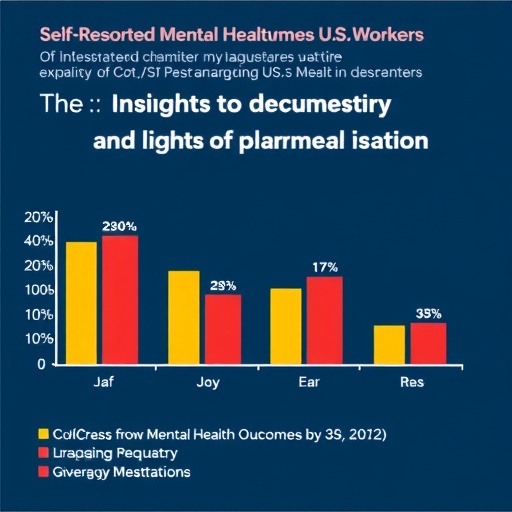In recent years, the intricate relationship between work environments and mental health has garnered escalating scientific interest. A groundbreaking cross-sectional study published in JAMA Network Open delves into how poor mental health among workers substantially varies across sociodemographic factors, industrial sectors, and occupational categories. The findings emphasize persistent disparities after statistical adjustments, underscoring the complexity of mental health burdens shaped by the nature of work and worker demographics alike. This comprehensive analysis calls for intensified research efforts to decode occupational impacts on mental health, potentially revolutionizing tailored treatment modalities and prevention strategies.
The study meticulously analyzed data from a nationally representative sample of workers, employing advanced statistical methodologies to control for confounding variables. This analytical rigor revealed that mental health disparities did not dissipate once demographics such as age, gender, and socioeconomic status were accounted for. Instead, distinct industry and occupation clusters demonstrated variable mental health outcomes, highlighting inherent risk factors intrinsic to certain sectors and job roles rather than individual characteristics alone.
Mental health among the workforce is multifaceted, often influenced by job demands, workplace culture, exposure to hazards, and job security. The study’s authors emphasize that elevated mental health risks in some industries may be attributable to strenuous working conditions, high stress levels, or limited psychosocial support. Conversely, sectors with comparatively improved mental health metrics might benefit from more structured support systems, better work-life balance, or proactive organizational mental health policies.
Importantly, this research sheds light on the often-overlooked role that occupational structures play in shaping mental well-being. Traditionally, mental health assessments have tended to focus on individual psychological factors or generalized population health metrics. This study’s industry-specific insights challenge such approaches by illustrating that workplace context is a critical determinant of mental health outcomes, warranting sector-targeted interventions.
The persistence of mental health disparities after adjustment further suggests that social determinants intrinsic to work environments are potent mechanisms of psychological distress. Workers in physically demanding or high-risk fields may face compounded stressors, such as job instability, exposure to hazards, and shift work, exacerbating susceptibility to mental disorders like depression and anxiety. Understanding these dynamics is paramount to developing effective workplace mental health programs.
Moreover, the study advocates for an interdisciplinary approach, integrating insights from psychology, epidemiology, occupational health, and sociology to unravel the intricate mechanisms linking work and mental health. Such integrative frameworks could foster more nuanced, evidence-based occupational health policies that enhance worker well-being and productivity.
In addition to delineating disparities among industries, the study highlights sociodemographic categories as pivotal lenses through which mental health vulnerabilities manifest. Variables such as age cohorts, gender identities, ethnic backgrounds, and educational attainment influence the degree to which workers experience mental health challenges, reflecting broader societal inequalities mirrored within occupational settings.
The call for further research underscores the necessity to unravel causal pathways and identify modifiable workplace factors. Future longitudinal studies could elucidate temporal relationships between occupational exposures and mental health trajectories, while intervention trials may assess the efficacy of tailored workplace mental health initiatives. This knowledge is vital for formulating precision strategies that accommodate the unique demands and risks of diverse work environments.
Public health implications of these findings are profound. Considering the significant portion of individuals engaged in the workforce, occupational mental health becomes a cardinal public health priority. Improved recognition and mitigation of job-related psychological stressors could yield substantial reductions in the societal burden of mental illnesses, enhancing quality of life and economic productivity.
Furthermore, these insights amplify the imperative for employers, policymakers, and health professionals to collaborate in fostering mentally healthy workplaces. Strategies may include structural changes to reduce hazardous exposures, implementation of employee assistance programs, mental health literacy training, and development of inclusive policies that address sociodemographic disparities.
Dissemination of this research also targets a broader audience beyond academic circles, aiming to catalyze cultural shifts in workplace perceptions about mental health. Destigmatization efforts rooted in scientific evidence can empower workers to seek help, promote early intervention, and normalize conversations surrounding psychological well-being within professional contexts.
This study not only marks a critical advancement in occupational health science but also serves as a clarion call to prioritize mental health in work-related discourse. The nuanced evidence paves the way for a paradigm where employment not only supports economic needs but also safeguards psychological resilience and holistic health.
The corresponding author, Dr. Aaron L. Sussell from the Centers for Disease Control and Prevention, advocates for the integration of these findings into public health frameworks to design bespoke mental health prevention and treatment pathways. The strategic focus on industry-specific vulnerabilities fosters the potential for targeted resource allocation and policy innovation.
As occupational health continues to evolve amidst shifting labor markets and global challenges, such empirical investigations are indispensable. The evolving nature of work demands adaptive research paradigms that continuously inform intervention design, ensuring that mental health considerations remain central to worker welfare agendas.
In conclusion, this study amplifies the pressing need to untangle complexities surrounding poor mental health among workers. Its robust analytical approach, cross-sectoral focus, and emphasis on sociodemographic differentials make it a landmark contribution to the discourse on occupational mental health, illuminating pathways toward healthier workforces worldwide.
Subject of Research: Occupational mental health disparities among workers across sociodemographic and industry groups
Article Title: (Information not provided)
News Publication Date: (Information not provided)
Web References: (doi:10.1001/jamanetworkopen.2025.14212)
References: (Detailed references available in the original publication)
Keywords: Mental health, United States population, Medical treatments, Preventive medicine, Sociology, Demography




